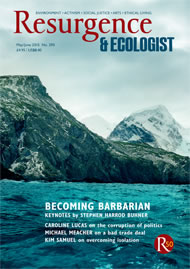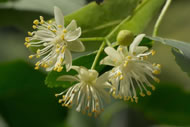We live in a time where the dominant mechanistic worldview of the last few centuries is becoming increasingly exposed as an inadequate interpretation of the interdependent nature of life. But because this ideology has dominated our ideas of how we should grow our food, rear our animals, raise our children, heal our society and look after our planet, we have largely forgotten quite how important the web of life is. Plants take a lead role in this mysterious play of life, providing, in one way or another, most of our clothes, our shelter, our food and our medicine. It’s worth reflecting on this mutually beneficial plant-human bond, and on how re-engaging with the web of life may improve all our futures.
The story of life is really one of sharing and reciprocity. Ever since the earliest blue-green cyanobacteria such as spirulina ‘learned’ 2 billion years ago to harness the sun’s energy, green plants have been generating the energy of life. We have been interacting, communicating and growing with our environment since time began, with plants and animals developing into the life forms they express today because of this incessant sharing. As we evolved together with the plant kingdom, we both learned how to use each other for mutual advantage. It’s testimony to the success of this evolutionary relationship that our bodies are able to recognise and benefit from the natural phytochemicals developed within plants: a relationship so successful that the health of our cardiovascular, digestive, immune, respiratory, nervous, endocrine and psychological systems is largely dependent on plants.
Plants have developed strategies that attract insects, animals and the wind to carry their procreative pollen far and wide. A spectrum of colours, tempting aromas and the reward of some sweet nectar lie in exchange for this fertile foray. However, in more defensive modes, plants have developed protective compounds that help guard them against damage from a plethora of microbes. Peppermint, for example, has developed powerful essential oils to ward off fungal invasions. In response, these little microbes have over time evolved new challenges to threaten the plant’s defences. And so the dance continues, the plant developing novel and useful compounds to respond to the microbes’ ever-evolving reproductive intentions. Our use of these botanical species over millennia suggests that bacteria, fungi and viruses have less ability to develop resistance to a broad-spectrum botanical pharmacy than to a narrow pharmaceutical one as used in our modern health system. Plants long used by cultures all over the world, such as andrographis, neem and elderberry, all display a potent ability to ward off infections and avoid creating antibiotic resistance.
Plants have developed a plethora of these phytochemical compounds, empowering them with broad-spectrum protection: for example, essential oils, polyphenols or steroids that help to protect and strengthen the plant. Many species have 1,000-plus compounds at very low levels of concentration. Animals and humans have discovered how to use these plants for a wide range of health benefits, and over the years we have learnt how to use 50,000 of the more than 250,000 species of flowering plants in the world. The history of medicine is in great part the history of herbal medicine, with the great cultures of medicine from the Americas, Europe and Asia collated by such giants as Hippocrates, Galen, Culpeper, Charaka, Sushruta, Huang Di and Li Shi Zhen, harnessing these insights into codified and systematic scientific medical traditions. As we learned to tap into Nature’s innate healing vitality we also learned that plants help our bodies and minds heal; they help us fulfil our potential.
Mutually beneficial reciprocity, sharing and learning are found at the heart of most symbiotic relationships. It’s the idea of being selfishly wise and wisely selfish: you look after yourself so you are well enough to look after others, and look after others so they are well enough to look after you, be you bee, butterfly, blueberry or human being. Of course, some species are certainly dangerous to us, but if we can heighten our already remarkable knowledge of how certain plants can benefit our health, they will flourish and so will we.
Until about 100 years ago we used to keep healthy by eating over 100 plant species, but for most people today that figure is down to around 10–20. That means we are exposed to much less of Nature’s phytochemical benefits every day. Because the variety of plants and herbs in our diet has radically diminished, we are no longer bathing our cells in as broad a spectrum of plant protection as we did through all of our earlier evolution, and this is one of the reasons our society’s health is suffering today.
A study carried out a couple of years ago by David Blanchflower and colleagues at the University of Warwick and published in 2012 showed how our happiness is directly connected with the amount of fruit and vegetables we eat. The work of Paul Clayton and Judith Rowbotham describing how our diets have declined in nutritional diversity since the Victorian 1870s when chronic disease rates were 90% lower than today underscores the value of diversity. One way of broadening our nutritional horizons is to include more of the less well-known plants in our diet, such as those used in the herbal tradition – for example liquorice, lemon balm and lime flower.
The ability that plants have learnt to protect themselves from invading microbes and extreme climates is remarkable. That these same evolutionarily familiar qualities can help our lives flourish is surely common sense. Just as the spicy compounds, aromatic terpenes and colourful flavonoids that you can find in ginger, tulsi and turmeric help the plant flourish, they also interact with our whole mental-emotional-immune network to optimise our response to just about everything. They can help stop a virus replicating, they can kick-start our nervous system to ameliorate pain, they can boost our fertility, and they can lift our mood when we feel threatened. As they interact with our genes, cells, tissues, organs and spirit, plants literally help us to influence our destiny.
This is no simple thing. We have an extraordinary and complex physiology, and yet minute levels of plant compounds can profoundly influence our health. Our human genome has evolved by selecting a vast array of low-level plant compounds to benefit its progress. Over the last 10 million or so years our human genetic experiment has been the story of how we utilise infinitesimally small amounts of phytochemicals to help us thrive. Conversely, the last 100 years or so has been a health experiment in how we use high-dose single chemicals, resulting in some, albeit isolated, remarkable success stories as well as some notorious tragedies.
As we face an explosion of system-wide disorders, such as diabetes, cancer and emotional imbalances, illnesses that do not hugely benefit from the single chemical approach, it’s not a big leap to conclude that we need a more developed system-wide approach to healing. Billions have been spent to tell us the obvious: that the basis of good health is good diet, exercise and lifestyle. Billions more have been spent trying to prove that single-molecule medicine works. But the dangers of the ‘magic’ bullets of modern pharmacology are becoming clearer. It’s time for the magic ‘web’ to take back centre stage; the plants and the tradition of herbal medicine are all around to help.
On a softer note, and beyond just their compounds, plants have a character unique to themselves expressing a knowable personality. We don’t just need to know what’s ‘in it’: we need to know ‘who’ it is. Quantum physics lauds the value of observation as the keystone to understanding reality; Einstein, Bohm and Goethe, in contrast to Descartes and Dawkins, all champion the value of the phenomena above the theory, and this makes each of us the most important scientist in the world. Experiment for yourself and see: some plants are lively (chew some ginger) and some are much more mellow (sip some chamomile). Some awaken our hearts (just look at a rose) and others simply make us happy (too many to mention, but lemon balm and tulsi sing from the treetops). Whatever they do, plants share life with us, and we have developed complex physiological systems to understand them. We just need to open our hearts and minds as we see, smell, taste, touch and listen.
Traditional health systems, such as Ayurveda, teach us to open our senses and read the language of Nature; their insights offer an amazing way to tell the story of plants and how we can benefit from them. How one plant, like ginseng, surviving through the harshest winters, can bring us warming strength, or another, like aloe vera, thriving in the hot desert, can soothe our burns. Or we can appreciate for a moment that just as cinnamon thrives in the humid jungle, its drying heat can help protect us from drizzle and damp, or how sweet elderberry fruits help soothe us through the winter. Understanding more about how plants cope with extreme conditions can tell us a lot about their beneficial health properties. Observing Nature, as opposed to just measuring her, teaches us that our perception is more important than anything else; our life is literally ours to perceive.
As we experience the power of Nature, and we come to terms with the awe of her magnificence, we end up in a place of mystery and wonder. How we live together as a community, how we perceive our environment, as we engage on a global level with all the plants, people and planet, is the story of life… One of sharing and reciprocity as part of the wholeness of the universe.








